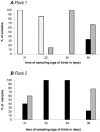Colonisation of a phage susceptible Campylobacter jejuni population in two phage positive broiler flocks
- PMID: 24733154
- PMCID: PMC3986380
- DOI: 10.1371/journal.pone.0094782
Colonisation of a phage susceptible Campylobacter jejuni population in two phage positive broiler flocks
Abstract
The pathogens Campylobacter jejuni and Campylobacter coli are commensals in the poultry intestine and campylobacteriosis is one of the most frequent foodborne diseases in developed and developing countries. Phages were identified to be effective in reducing intestinal Campylobacter load and this was evaluated, in the first field trials which were recently carried out. The aim of this study was to further investigate Campylobacter population dynamics during phage application on a commercial broiler farm. This study determines the superiority in colonisation of a Campylobacter type found in a field trial that was susceptible to phages in in vitro tests. The colonisation factors, i.e. motility and gamma glutamyl transferase activity, were increased in this type. The clustering in phylogenetic comparisons of MALDI-TOF spectra did not match the ST, biochemical phenotype and phage susceptibility. Occurrence of Campylobacter jejuni strains and phage susceptibility types with different colonisation potential seem to play a very important role in the success of phage therapy in commercial broiler houses. Thus, mechanisms of both, phage susceptibility and Campylobacter colonisation should be further investigated and considered when composing phage cocktails.
Conflict of interest statement
Figures



Similar articles
-
The in vivo efficacy of two administration routes of a phage cocktail to reduce numbers of Campylobacter coli and Campylobacter jejuni in chickens.BMC Microbiol. 2010 Sep 1;10:232. doi: 10.1186/1471-2180-10-232. BMC Microbiol. 2010. PMID: 20809975 Free PMC article.
-
Bacteriophage therapy to reduce Campylobacter jejuni colonization of broiler chickens.Appl Environ Microbiol. 2005 Nov;71(11):6554-63. doi: 10.1128/AEM.71.11.6554-6563.2005. Appl Environ Microbiol. 2005. PMID: 16269681 Free PMC article.
-
A Study on Campylobacter jejuni and Campylobacter coli through Commercial Broiler Production Chains in Thailand: Antimicrobial Resistance, the Characterization of DNA Gyrase Subunit A Mutation, and Genetic Diversity by Flagellin A Gene Restriction Fragment Length Polymorphism.Avian Dis. 2017 Jun;61(2):186-197. doi: 10.1637/11546-120116-Reg.1. Avian Dis. 2017. PMID: 28665716
-
Phenotypic and genotypic methods for typing Campylobacter jejuni and Campylobacter coli in poultry.Poult Sci. 2012 Jan;91(1):255-64. doi: 10.3382/ps.2011-01414. Poult Sci. 2012. PMID: 22184452 Review.
-
Poultry as a host for the zoonotic pathogen Campylobacter jejuni.Vector Borne Zoonotic Dis. 2012 Feb;12(2):89-98. doi: 10.1089/vbz.2011.0676. Epub 2011 Dec 1. Vector Borne Zoonotic Dis. 2012. PMID: 22133236 Review.
Cited by
-
1st German Phage Symposium-Conference Report.Viruses. 2018 Mar 29;10(4):158. doi: 10.3390/v10040158. Viruses. 2018. PMID: 29596346 Free PMC article.
-
Microbiota from Specific Pathogen-Free Mice Reduces Campylobacter jejuni Chicken Colonization.Pathogens. 2021 Oct 27;10(11):1387. doi: 10.3390/pathogens10111387. Pathogens. 2021. PMID: 34832543 Free PMC article.
-
Therapeutic and protective approaches to combat Campylobacter jejuni infections.Front Pharmacol. 2025 May 6;16:1572616. doi: 10.3389/fphar.2025.1572616. eCollection 2025. Front Pharmacol. 2025. PMID: 40395728 Free PMC article. Review.
-
Isolation and Characterization of Group III Campylobacter jejuni-Specific Bacteriophages From Germany and Their Suitability for Use in Food Production.Front Microbiol. 2021 Dec 9;12:761223. doi: 10.3389/fmicb.2021.761223. eCollection 2021. Front Microbiol. 2021. PMID: 34956123 Free PMC article.
-
Antimicrobial effect of a drinking water additive comprising four organic acids on Campylobacter load in broilers and monitoring of bacterial susceptibility.Poult Sci. 2022 Dec;101(12):102209. doi: 10.1016/j.psj.2022.102209. Epub 2022 Sep 25. Poult Sci. 2022. PMID: 36283144 Free PMC article.
References
-
- Kutateladze M, Adamia R (2010) Bacteriophages as potential new therapeutics to replace or supplement antibiotics. Trends Biotechnol 28: 591–595. - PubMed
-
- Greer GG (2005) Bacteriophage Control of Foodborne Bacteria. J Food Prot 68: 1102–1111. - PubMed
-
- Janez N, Loc-Carrillo C (2013) Use of phages to control Campylobacter spp. J Microbiol Methods 95: 68–75. - PubMed
-
- EFSA (2013) The European Union Summary Report on Trends and Sources of Zoonoses, Zoonotic Agents and Food-borne Outbreaks in 2011. EFSA Jounal 11: 3129. - PubMed
Publication types
MeSH terms
Substances
LinkOut - more resources
Full Text Sources
Other Literature Sources
Medical
Molecular Biology Databases

